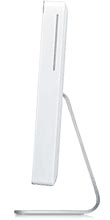CES is coming. Prepare yourself for the flood.
In an effort to get heard above the noise of CES, HP has this morning announced a couple of products that will be capable of receiving and storing High Definition TV (HDTV).
The first is an extension to their current Digital Entertainment Center (DEC) range that will add high-definition ATSC (Advanced Television Standards Committee) tuning capabilities. Two models are expected to ship this spring with different storage, graphics card and tuning options.
The second is the industry’s first HDTV media hub which comes with dual-tuners and expected for release in autumn 2005. It will handle all of the now-expected digital photos, music and videos and act as a digital video recorder (DVR). While HD tuning cards have been available for some time, this is the first time that a mainstream company has announced a HDTV product.
We contacted HP for further details about the products support for the US Broadcast Flag, but as yet they were unable to provide it. Given the release date of the product is after the July 2005 compulsory support date, and that it’s a US-focused product it is highly likely that the equipment will support the Broadcast Flag.
Given HP partnership with Philips in the Video Content Protection System (VCPS), an FCC-approved technology designed to restrict the copying of video content to DVD, it is highly likely that this will be included too.
Of particular interest is HP’s inclusion of an “intuitive Electronic Programming Guide” designed by them to “allow consumers to easily find and record the content they want.” There are no details of this being a free or fee service.
We see this as HP’s move to become the gateway to access on-demand content of all sorts. This is further demonstrated by their mention of delivering “upgrades the device with new services.” It’s a smart move, placing themselves in this pivotal position before someone else gets in there to provide a service.
It’s not just computer-based equipment that HP is offering in HD world. They’ve also announced plans to introduce a full line of 17 new HDTVs and home theater projectors based on HP-developed “visual fidelity” technologies.
One of these is the spectacularly named “wobulation” technology, a patent-pending method to provide twice the resolution of digital projection displays without increasing the cost.
 Apple have unveiled their new G5 iMac, with a radical break in the series’ all-in-one design. The iMac now comes in a 20” and 17” TFT format – and the whole computer is built into the screen, making it just 2” thick.
Apple have unveiled their new G5 iMac, with a radical break in the series’ all-in-one design. The iMac now comes in a 20” and 17” TFT format – and the whole computer is built into the screen, making it just 2” thick.